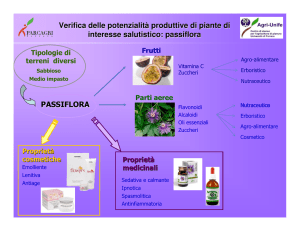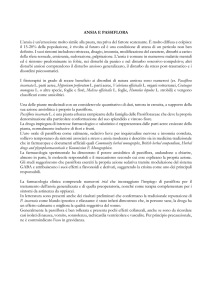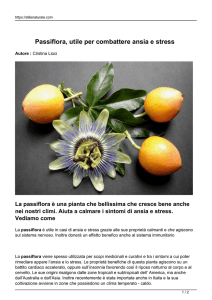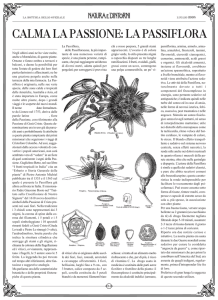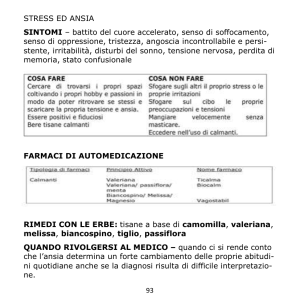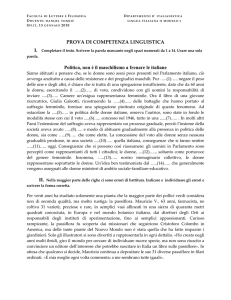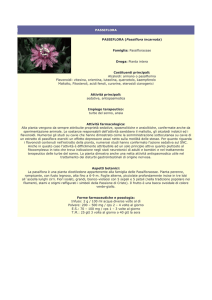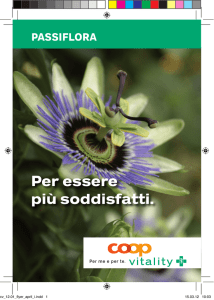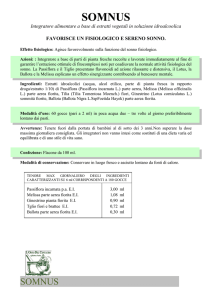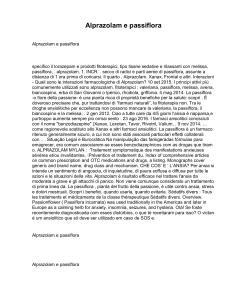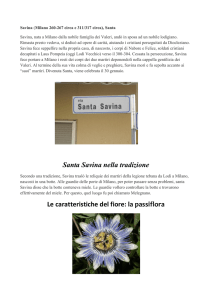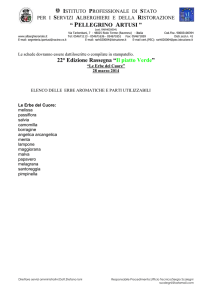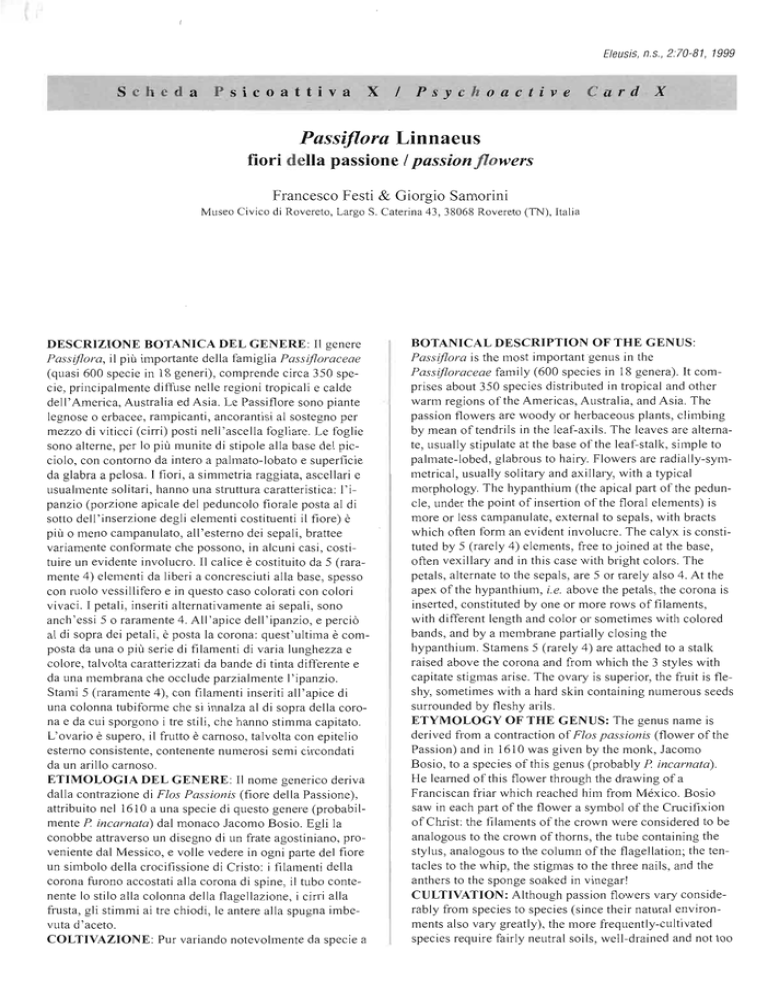
Eleusis, n.s., 2.70-81, 1999
S ched a
P sicoattiva
X /
Pass~flora
Psyc h oactive
C ard X
Linnaeus fiori della passione / passion flowers Francesco Festi & Giorgio Samorini Museo Civico di Rovereto, Largo S. Caterina 43, 38068 Rovereto (TN), Italia DESCRIZIONE BOTANICA DEL GENERE : Il genere
Passiflora, il più importante della famiglia Passifloraceae
(quasi 600 specie in 18 generi), comprende circa 350 spe­
cie, principalmente diffuse nelle regioni tropicali e calde
dell' America, Australia ed Asia. Le Passi flore sono piante
legnose o erbacee, rampicanti, ancorantisi al sostegno per
mezzo di viticci (cirri) posti nell'ascella fog li are. Le foglie
sono alterne, per lo più munite di stipo le alla base del pic­
ciolo, con contorno da intero a palmato- Iobato e superficie
da glabra a pelosa. I fiori , a simmetria raggiata, ascellari e
usualmente solitari , hanno una struttura caratteristica: l'i­
panzio (porzione apicale del peduncolo fiorale posta al di
sotto dell'inserzione degli elementi costituenti il fiore) è
più o meno campanulato, all'esterno dei sepali, brattee
variamente conformate che possono, in alcuni casi , costi­
tuire un evidente involucro. Il calice è costituito da 5 (rara­
mente 4) elementi da liberi a concresciuti alla base, spesso
con ruolo vessillifero e in questo caso colorati con colori
vivaci. I petali, inseriti alternativamente ai sepali, sono
anch 'essi 5 o rara mente 4. Ali 'apice dell ' ipanzio, e perciò
al di sopra dei petali, è posta la corona: quest ' ultima è com­
posta da una o più serie di filamenti di varia lunghezza e
colore, talvolta caratterizzati da bande di tinta differente e
da una membrana che occlude parzialmente l'i panzio.
Stami 5 (raramente 4), con filamenti inseriti al l'apice di
una colonna tubiforme che si innalza al di so pra della coro­
na e da cui sporgono i tre stili, che hanno stimma capitato.
L'ovario è supero, il frutto è carnoso, talvolta con epitelio
esterno consistente, contenente numerosi semi circondati
da un arillo carnoso.
ETIMOLOGIA DEL GENERE: Il nome generico deriva
dalla contrazione di Flos Passionis (fiore della Passione),
attribuito nel 1610 a una specie di questo genere (probabil­
mente P incarnata) dal monaco Jacomo Bosio. Egli la
conobbe attraverso un disegno di un frate agostiniano, pro­
veniente dal Messico, e volle vedere in ogni parte del fiore
un simbolo della crocifissione di Cristo: i filamenti della
corona furono accostati alla corona di spine, il tubo conte­
nente lo stilo alla colonna della flagellazione, i cirri alla
frusta, gli stimmi ai tre chiodi, le antere alla spugna imbe­
vuta d'aceto.
COLTIVAZIONE: Pur variando notevolmente da specie a
BOTANICALDESCRIPTION OFTHE GENUS :
Passiflora is the most importantgenus in the
Passifloraceae family (600 species in 18 genera). It com­
prises about 350 species distributed in tropical and other
warm regions ofthe Americas, Australia, and Asia. The
passion flowers are woody or herbaceous plants, climbing
by mean of tendrils in the leaf-axils. The leaves are alterna­
te, usually stipu late at the base ofthe leaf-stalk, simple to
palmate-Iobed, glabrous to hairy. Flowers are radially-sym­
metrical, usually solitary and axillmy, with a typical
morphology. The hypanthium (the apical part of the pedun­
cle, under the point of insertion of the floral elements) is
more or less campanulate, external to sepals, with bracts
which often form an evident involucre. The calyx is consti­
tuted by 5 (rarely 4) elements, free to joined at the base,
often vexillary and in this case with bright colors. The
petals, alternate to the sepals, are 5 or rarely also 4. At tbe
apex ofthe hypanthium, i.e. above the petals, the corona is
inserted , constituted by one or more rows offilaments,
with different length and color or sometimes with colored
band s, and by a membrane partially closing the
hypanthium . Stamens 5 (rarely 4) are attached to a stalk
raised above the corona and from which the 3 styles with
capitate sti gmas ar ise. The ovary is superior, the fruit is fle­
shy, sometimes with a hard skin containing numerous seeds
surrounded by fleshy arils.
ETYMOLOGY OF THE GENUS: The genus name is
derived from a contraction of Flos passionis (flower ofthe
Passion) and in 1610 was given by the monk, Jacomo
Bosio, to a species ofthis genus (probably P incarnata).
He learned of this flower through the drawing of a
Franciscan friar which reached him from México. Bosio
saw in each part of the flower a symbol of the Cmcifixion
of Christ: the fi laments of the crown were considered to be
analogous to the crown of thorns , the tube containing the
sty lus, analogous to the columo of the fl agellatioo; the ten­
tacles to the whip, the stigmas to the three nails, and the
anthers to the sponge soaked in vinegar'
CULTIVATION: Although passion flowers vary conside­
rably from species to species (since their natural eoviron­
ments also vary greatly), the more frequeotly-cultivated
species require fairly neutral soils, well-drained and not too
FRAN CESCO FESTI
& GIORGIO
SAMORINI
specie (si tenga conto che il loro ambiente naturale di cre­
scita è notevolmente vario) si può dire in generale che le
passiflore più largamente coltivate prediligono terreni più o
meno neutri , ben drenati e non troppo ricchi di nitrati .
L'eccessiva annaffiatura va evitata e, per una rigogliosa
fioritura, è consigliabile utilizzare in primavera concimi a
base di potassio. La pacciamatura con paglia o altro mate­
riale protegge le radici dal freddo invernale e dali 'eccessiva
evaporazione durante l'estate. La potatura di controllo va
eseguita in primavera o in estate. La riproduzione più facil­
mente attuabile è quella per talea. Più problematica, anche
per la difficoltà di reperimento dei semi , è la riproduzione
per seme. Si tenga presente che le passi flore sono piante di
climi caldi e che solo pochissime specie possono sopravvi­
vere al clima atlantico dell ' Europa centro-settentrionale: la
loro coltivazione in terra piena è perciò possibile solo nei
paes i mediterranei ed in genere in quelli più meridionali.
DATI ETNOBOTANICI: Le passi flore potrebbero essere
considerate come fonti di alcaloidi beta-carbolinici, carat­
terizzati dall'indispensabile effetto MAO-inibitore nelle
combinazioni di vegetali psicoattivi che vanno sotto il ter­
mine di anahuasca o analoghi dell ' ayahuasca (Orr J 994) .
Un 'autosperimentazione effettuata combinando e ingere.n­
do l'infuso di foglie di P incarnata e di Psychotria viridis
(queste ultime contenenti DMT) avrebbe indotto un ' espe­
rienza decisamente "psichedelica" (ANON IMO J 995).
Diverse specie vengono coltivate come piante ornamentali
o per il frutto edule o usate come medicinal i.
DATI BIOCHIMICI: Diverse specie di pass iflore produ­
cono alcaloidi beta-carbolinici , in particolare armano (=
passiflorina) e armina, soprattutto nelle foglie. Alcune spe­
cie producono anche maracugina, un alcaloide apparente­
mente non beta-carbolinico che possiede proprietà sedative
(cfr. NEUGEBAUER 1949, cito in HEGNAUER 1969). E' stata
segnalata inoltre la presenza di flavonoidi, serotonina
(soprattutto nei frutti) , triptamina, noradrenalina e glicosidi
cianogeni.
71
Eleusis, n.s, n. 2, 1999
rich in nitrates . They should not be over-watered and pota­
sh should be fed in the spring for better blooms. Mulching
with straw or other materials will protect the roots from the
cold during the winter months and from excessive evapora­
tion during the summer. Pruning or recision should be car­
ried out during the spring or summer. Piping is the easiest
form of reproduction. Seed reproduction is more difficult
becau se it is hard to gather the seeds. Passion flowers are
hot-climate plants and very few wi Il survive the Atlantic
climate of northern and centrai Europe. Open-field cultiva­
tion is therefore only possible in Mediterranean countries
and further south.
ETHNOBOTANICALDATA: Passion tlowers are a sour­
ce of beta-carboline alkaloids, which are sometimes used
for their MAO-inhibitory effect in combinations with psy­
choactive plants, known generically as anahuasca or
ayahuasca analogues (Orr 1994) . lt has been reported that
self-experimentation - performed by taking an infusion of
leaves of P incarnata and Psychotria viridis - brings about
decidedly "psychedelic" effects (Psychotria viridis con­
tains DMT) (ANONYMOUS 1995). Various species are culti­
vated as ornamental plants or for their edible fruits; alterna­
tively they are used for their medicinal properties.
BIOCHEMICAL DATA: Many species of passion flowers
produce beta-carboline alkaloids, particularly harman (=
passiflorine) and harmine, and especially in the leaves .
Some species produce al so maracugine, apparently not a
beta-carboline alkaloid, having sedative properties (cfr.
NEUGEBAUER 1949, cito in HEGNAUER 1969). lt has also
been determined that flavonoids, serotonine (especially in
the fruits), tryptamine, noradrenaline, and cyanogenic gly­
cosides may be present.
Passiflora alata Dryander (Botanical Magazine, 1781: 66)
SINONIMI I SYNONYMS: P angulata Sweet; P brasiliana Desf.; P citrifolia Salisb.; P latifolia DC. ; P maliformis VelI.; P mauritiana Thou .; P pedunculata Hort. ex Mast. ; P phoenicea LindI.; P tetradena Vand. ex DC. NOMI VERNACOLARI / VERNACULAR NAMES: maracuja (Brasile/Brasi/) ; maracuya (Perù/Peru) DESCRIZIONE BOTANICA: Nome specifico dal latino
alatus = munito di ali, in riferimento alle strette ali mem­
branose portate dal fusto. Molto simile a P quadrangu­
laris, con la quale viene spesso confusa. Se ne distingue
per le stipo le più piccole (larghe al massimo fino a 1 cm),
la corona costituita da due serie di filamenti , i più esterni
lunghi 2-2 .5 cm (corona in più serie di filamenti, lunghi
fino a 4 cm in P quadrangularis), i sepali ad apice acumi­
nato e peduncolo fiorale a sezione circolare.
Orig inaria dell ' America meridionale (Brasile), viene
coltivata, oltre che per ornamento, anche per il frutto, parti­
colarmente ricercato per la produzione di succhi.
Una cultivar diffusa in Europa è la Ruby Glow, con
dimensioni più ridotte rispetto al tipo e quindi di più agevo­
le utilizzo come pianta da appartamento .
DATI BIOCHIMICI: Nelle radici sono stati ritrovati
0.28% di armano (= passiflorina) , 0.152% di maracugina e
BOTANICAL DESCRIPTION: Specific name comes
from the Latin word alatus (= winged), referring to the nar­
row membranous wings supported by the stem. This is
quite similar to P quadrangularis , with which it is often
mistaken . lt is differentiated from the latter by smaller sti­
pules (no more than I cm broad), corona constituted by
two seri es of filaments, of which the exterior is 2-2.5 cm
long (in P quadrangularis, corona constituted by a pluri­
series of filaments, up to 4 cm long), sepals with acuminate
apex and terete peduncle. This species is indigenous from
South America (Brasi I), and is cultivated as an ornamental
plant and also for the fruits, especially esteemed for
making juices. A common cultivar in Europe is "Ruby
Glow," with more reduced size as opposed to the type, and
therefore more suitable as a plant for flats.
BIOCHEMICAL DATA: Roots: 0.28% harman (= passi­
florine) , 0.152% maracugine, 0.31% passiflortannoid; lea­
FRANCESCO FESTI
& GIORGIO
72
SAMORINI
0.3 l % di passiflortannoide; nelle foglie 0.082 % di armano
(PECKOLT 1909). Più recentemente, nelle foglie sono stat i
ritrovati alcaloidi beta-carbolinici in concentrazioni dello
0.217mg% e f1avonoidi (fra cui vitessina, isovitessina e
isoorientina) in quantità di 44.8mg% nell'estratto secco
(OGA et al. 1984).
USI NELLA MEDICINA POPOLARE: Specie officina le
utilizzata in Brasile contro l'insonnia e l'ansia
(WANNMACHER et al. 1990).
DATI FARMACOLOGICI: L'estratto secco provoca
depressione del SNC nel topo ; prolunga il tempo di sonno
indotto da pentobarbital e riduce in maniera significativa
l'attività motaria spontanea (OGA et al. 1984).
Eleusis, n.s., n. 2, 1999
ves: 0.082% harman (PECKOLT 1909). More recentIy, bela­
carboline alkaloid concentrations of 0.217 mg% and f1avo­
noids (including vitexin, isovitexin and isoorientin) have
been found in the leaves in quantities of 44.8 mg% (OGA et
al. 1984).
POPULAR MEDICINAL USES: Officinal plant used in
Brasil against insomnia and anxiety (WANNMACHER et al.
1990).
PHARMACOLOGICALDATA: A dried extract caused
central-nervous-system depression in mice; it prolonged
the sleeping time induced by pentobarbital and reduced
significantly spontaneous motor activity (OGA et al. 1990).
Passiflora caerulea L. (Species Plantarum , 175 3: 959)
SINONIMI / SYNONYMS: P hartwiesiana Hort. ex Masl.; P mayana Veitch ex Voigt.; P stenophylla Hoffmgg. NOMI VERNACOLARI / VERNACULAR NAMES: passiflora,fìore della passione (il.) # blue passionjlower; blue pas­
sion vine (ingUEngl.) # Blaue Passionblume (ted./Germ.) # Grenadil/e bleue (fr.) # pasiflora,pasionaria,jlor de pasion (sp.) # mburucuya (Argentina)
DESCRIZIONE BOTAN ICA: Nome specifico dal lati no
caeruleus= ceruleo, azzurro, per le tinte del fiore . Fusto
legnoso (che può tuttavia morire completamente in autunno
nei climi più freddi , per rigettare alla base in primavera) a
sezione quadrangolare. Foglie 3-5 (7)-lobate, glabre, con
dimensioni medie di IO x 15 cm e picciolo portante 2-4 (6)
ghiandole. Brattee largamente ovate, raggiungenti i 2 cm di
diametro. Fiori poco profumati, con sepali oblunghi, 3.5 x
1.5 cm, bianchi. Petali un po' più larghi dei sepali, da bian­
chi a bianco-rosei sulla faccia interna. Filamenti della coro-
BOTANICAL DESCRIPTION: The specific name come
from the Latin word caeruleus (= caerulean, blue), refer­
ring to the color ofthe f1owers. Woody stem (which may
however die completely in autumn in co lder climates and
resprout at the base in springtime) with quadrangular sec­
tion. Leaves 3-5(7)-lobate, glabrous, with an average size
of lO x 15 cm , the petiole with 2-4(6) glands. Bracts
broadly ovate, reaching 2 cm in diameter. Flowers slightly
fragrant , with oblong sepals, 3.5 x 1.5 cm, white. Petals a
little broader than the sepals, white to rosy-white on their
Passiflora caeru{ea L. (da l/rom SGA RAVAHI &
ZARDINI
1997)
FRANCESCO FESTI
& GI ORGIO
73
SAMORINI
na in più serie, lunghi fino a 2 cm, per lo più diritti, blu
nella parte distale, bianchi al centro e porpora alla base.
Frutto ovale, aranciato, circa 6 x 3 cm, in sipido (talvolta
consumato cotto, mescolato ad altra frutta) .
Originaria dell ' America meridionale (Bras ile­
Argentina), è una delle specie più largamente coltivate,
adattandosi anche a climi più o meno temperati; è stata
riportata come naturalizzata nelle Azzorre (BALL in TUTlN
e/ al. 1968), inselva tichita in Italia nei dintorni dei Laghi di
Garda e di Como (PIGNATTI 1982) e si rin v iene talvolta
come avventizia effimera nei paesi più caldi dell'Europa .
Tra le cultivar più conosciute si possono citare la
Cons /ance Elliot, che ha fiori e filamenti della corona com­
pletamente bianchi, la Grandiflora, con fiori il cui diametro
può raggiungere i IO cm e la Chinensis, i cui fiori hanno
una tinta azzurra. Numerosi sono anche gli ibridi di origine
orticulturale, tra cui i più diffusi sono: P X belotii Pepin (=
p X alato-caerulea Lindley; P X p/ordtii nom. inv.; P
"Imperatrice Eugenie "; P "Empress Eugenie ") o P alata
Curtis X caerulea L.; P X allardii Lynch. O P caerulea L.
"Constance Elliot" X quadrangularis L.; P X caeruleo­
racemosa Sabine (= P X tresederi nom. inv.) o P caerulea
L. X racemosa Brotero (con diverse cultivar); P X colvillii Sweet o P incarnata L. X caerulea L. DATI BIOCHIMICI: Produce alcaloidi beta-carbolinici, fra cui armina, armolo, armano (AMBHDL 1966, cito in BANDONI et al. 1972), con una concentrazione di alcaloidi totali di 8.2 mgll OOg (LOHDEFINK & KATING 1974). Passijlora caentfea L (da I from
Eleusis, n.s , n. 2, 1999
internai face. Filaments of the corona pluri-seriate, up to 2
cm long, mostly straight, blue on the distaI side, white at
the center, and purple at the base. Fruit ovai , orange, about
6 x 3 cm, insipid (sometimes eaten cooked, mixed with
other fruits). This species is indigenous to South America
(Brasil, Argentina), it is one of the most widely-cultivated
species, adapting also to more or less temperate climates; it
has been reported to be naturalized in the Azores (BALL in
TUTIN et al. 1968), grows wild in ltaly in the surroundings
of the Garda and Como Lakes (PIGNATTI 1982), and is
found sometimes as an ephemeral adventive in the warmest
countries of Europe. Among the best-known cultivars are:
"Constance ElIiot," with flowers and filaments of the coro­
na completely white; "Grandiflora," with the diameter of
the flowers reaching lO cm; "Chinensis," with blue
flowers. There exist many hybrids of horticultural origin,
the most widespread of which are: P X belotii Pepin (= P
X alato-caerulea Lindley; P X p/ordtii nom. inv.; P
'Imperatrice Eugenie '; P 'Empress Eugenie ') or P alata
Curtis X caerulea L.; P X al/ardii Lynch. or P caerulea L.
'Constance Elliot' X quadrangularis L.; P X caeruleo­
racemosa Sabine (= P X tresederi nom. inv.) or P caerulea
L. X racemosa Brotero (with different cultivars); P X col­
villii Sweet or P incarnata L. X caerulea L.
BIOCHEMICALDATA: This species produces be/a-car­
boline alkaloids, including harmin, harmol , and harman
(AMBHUL 1966, ci/o in BANDONI et al. 1972) with a total
alkaloids concentration of 8.2 mgllOOg (LOHDEfINK &
GERARD
1633, The Herba{J
FRANCESCO FESTI
& GIORGIO
SAMORINI
Produce anche kaempferolo, quercetina (TRONCHETE 1960, cito in BANDON I et al. 1972) e licopina (KARRER 1958, cit. in BA NDON I et al. 1972). USI NELLA MEDICINA POPOLARE: In Argentina è considerata specie medicinale, usata come antielmintica, sedativa, diuretica, emmenagoga, antiscorbutica e anti-itte­
rica (BANDONI et al. 1972). In Italia viene usata come anti­
spasmodico e sedativo (WATT & BREYER-BRANDWIJK 1962). DATI FARMACOLOGICI: Nella pianta è stata ritrovata anche chrysina (5,7-di-OH-flavone), che agisce come 74
Eleusis, n.s., n. 2, 1999
KATING 1974). It produces also kaemferol , quercetin (TRONCHETE 1960, cito in BANDONI et al. 1972) and licopine (KARRER 1958, cito in BANDON I et al. 1972). POPULAR MEDICINAL USES: fn Argentina it is consi­
dered to be a medicinal species, used as an anthelmintic, sedative, diuretic, emmenagogue, antiscorbutic and anti­
icteric (BANDONI et al. 1972). In ltaly it is used as an anti­
spasmodic and sedative (WATT & BREYER-B RANDWlJK 1962). PHARMACOLOGICALDATA: Chrysin (5,7-di-OH-fla­
vone) has also been found in this plant. This compound acts as a ligand for benzodiazepine receptors, both centrai Passiflora rubra L. Passiflora foelida L. (da / from HOl_M-NI ELSEN et al. 1988) (da / from HOLM-NIELSEN et al. 1988) ligando per i recettori delle benzodiazepine, sia centrali che
periferici. Essa possiede un'azio ne miorilassan te e anticon­
vulsiva (MEDINA et al. J 990). Tuttavia, studi più recenti
hanno evidenziato l'assenza di questo composto in campio­
ni ita liani della pianta, cosÌ come un'azione farmacologica
della crys ina solo a concentrazioni superiori a quelle in
precedenza riportate da Medina et al. (SPERONI et al.
I 996a). Nelle foglie sono state rinvenute quantità variabili
di glicosidi cianogenici: la pianta fresca è pertanto conside­
rata tossica, potendo contenere fino a 6 mg di HCN per 100
g di materiale (Rom et al. 1984).
and peripheral, and it possesses myorelaxant and anticon­
vllisive actions (MEDINA et al. 1990). However, more
recent studies found the absence of this compound in
ltalian plants, the pharmacologic activity of chrysin being
found only at concentrations higher than those previollsly
reported by Medina et al. (SPERONI et al. 1996a). In the lea­
ves variable quantities of cyanogenic glycosides have been
found; the fresh plant is therefore considered to be toxic,
because it may contain up to 6 mg of HCN/ 100 g CRonI et
al. 1984).
FRANCESCO FESTI
& GIORGIO
SAMORINI
75
Eleusis, ns., n. 2, 1999
Passiflora edulis Sirns (Botanical Magazine , 18 18 : 1989) SINONIMI / SYNONYMS: P diade n VelI.; P incarnata Ker.-Gawl. non L.; P /ceri i Spreng.; P pallidiflora Bertol.; P pomife­
ra M. Roem.; P rubricaulis Jacq.; P verrucifera LindI. NOMI VERNACOLARI / VERNACULAR NAMES: rosa della passione (it.) # purple shelled passionfruit,purple grana­
dilla (ingl./Engl.) # granadille, Marie tambour, pomme !iane (fr.) # maracuja (port.) # granadilla (sp.) # parcha, parchita (Venezuela, Colombia). COROLOGIA: Nativa del Brasile, Paraguay e Argentina del Nord. Naturalizzata nel mondo nelle regio ni tropicali e subtropicali. DESCRIZIONE BOTANICA: Il nome specifico si riferi­
sce alla commestibilità del frutto (latino edulis = commesti­
bile). Simile a P incarnata ma con foglie lucenti di sopra, talvolta intere nelle piante giovani; petali e sepali bianchi all'interno; filamenti della corona porporini alla base e bianchi nella parte distale, quasi sempre sinuosi all 'apice. Originaria del Brasile, viene largamente coltivata
nelle regioni tropi ca li per il frutto particolarmente dolce e
profumato: la sua co ltivazione per lo stesso scopo è stata
pure tentata anche in altri paesi a clima caldo (per esempio
l'Italia meridionale, dove P edulis può produrre fino a due
raccolti all'anno) ma non si è rivelata concorrenziale rispet­
to ali ' importazione dali' America del Sud. Rimane invece
abbastanza diffusa nei giardini (climi temperato-caldi)
come pianta ornamentale.
Se ne conoscono diverse cultivar, sviluppate nei paesi
tropicali al fine di mi gliorare o modificare le caratteristiche
del frutto. Tra queste sono talvo lta coltivate in Europa la
var. Crackerjac/c, che si disti ngue per i frutti di co lore por­
porino, e la var.jlavicarpa Degen, a frutti gialli e fiori più
grandi.
DATI BIOCHIMICI: Produce alcaloidi beta-carbolinici e
derivati triptaminici semplici. NeJJe foglie sono stati ritro­
vati 0.196% di maracugina e 0.42% di passiflortannoide
(PECKOLT 1909), armano (LOHOEFlNK & KATlNG 1974;
SLAYTOR & McFERLANE 1968). Nelle foglie sono stati iden­
tificati triptamina e N-acetil-triptamina (SLAYTOR &
McFERLANE 1968). Più recentemente, nella form ajlavicar­
pa sono state riscontrate quantità di armano pari allo 0.7%
nelle foglie, 0.17% negli steli e nessuna quantità nelle radi­
ci (LUTOMSKf & MALEK 1975). Studi polacchi hanno evi­
denziato che i! contenuto di alcaloidi, in particolare armali­
na, è circa 6 volte maggiore nel succo del frutto della forma
jlavicarpa che della specie tipo (LUTOMSKT et al. 1975). Nel
frutto sono presenti glicosidi cianogenici, in pat1icolare
prunasina nella buccia e amigdalina nel succo (CHASSAGNE
et al. 1996). Per studi biosintetici si veda COPELANO &
SLAYTOR 1974.
USI NELLA MEDICINA POPOLARE: Pianta antiscor­
butica. In Africa (Madeira) i! frutto viene impiegato come
stimolante digestivo e nei carcinomi gastrici (WATT &
BRE YER-BRANowfJK 1962). Nel Malawi le foglie sono usate
nel trattamento dell'insonnia, dell 'epilessia e delle emicra­
nie (MORRIS 1996).
DATI FARMACOLOGICI: L' estratto acquoso deJJa
pianta mostra in laboratorio azioni caratteristiche di un
depressivo del SNC, con diminuzione della temperatura
corporea, potenziamento dell' azione di altri depressivi
quali la morfina e blocco parziale dell'azione stimolante
dell'amfetamina. 11 composto attivo sembra essere una pro­
teina o una qualche molecola associata alle proteine (Do
VALE & LETTE 1983).
CHOROLOGY: Native to Brasi!, Paraguay and nm1hern
Argentina. This species is now naturalized in tropical and
subtropical regions.
BOTANJCAL DESCRJPTION: Anatomy is similar to P
incarnata but with leaves glossy above, sometimes simple
in the young plants; petals and sepals white inside; corona­
filaments purple at the base and white in the distai parts,
almost always crinkled at the apex. Native to Brasil, it is
widely cultivated in tropical regions for the particularly fra­
grant and sweet fruits. Its cultivation for fruit production
has been attempted also in other warm countries (e.g.
Southern Italy, where P edulis can produce two harvests
yearly), but this does not compet with imports from South
America. It is quite widespread in temperate-warm-clima­
tes as an ornamental garden plant. Among the many culti­
vars developed in tropical countries to improve the charac­
ters ofthe fruit, var. 'Crackerjack,' with purple fruits, and
var.jlavicarpa Degen, with yellow fll.lits an d larger
flo wers, are sometimes cultivated in Europe.
BJOCHEMICALDATA: lt produces beta-carboline alka­
loids and simple tryptamine-derivatives. The leaves con­
tain: 0.196% maracugine, 0.42% passiflortannoid (PECKOLT
1909), and harman (LOHOEFINK & KATlNG 1974; SLAYTOR
& McFERLANE 1968) have been found. In the leaves also
tryptamine and N-acethyl-tryptamine (SLAYTOR &
McF ERLANE 1968). More recently, in the formjlavicarpa
harman has been found at the foJJowing concentrations:
0.7% in the leaves, 0.1 7% in the stems, none in the roots
(LUTOMSKI & MALEK 1975). Polish studies found that the
alkaloid content, espec ially ofharm ali ne, was about 6
times greater in the fruit juice of the forrnjlavicarpa than
in the type species (LUTOMSKI et al. 1975). Cyanogenic
glycosides are present in the fruit, especially prunasin in
the peel and amygda lin in the juice (CHASSAGNE et al.
1996). For biosynthetic studies, see: COPELANO & SLAYTOR
1974.
POPULAR MEDICINAL USES: This plant is used as an
antiscorbutico In Africa (Madeira) the fruit is used as a
digestive stimulant and in the treatment of gastric carcino­
ma (WATT & BREYER-BRANOWIJK 1962). In Malawi the lea­
ves are llsed in the treatment of insomnia, epilepsy, and
migraines (MORRIS 1996).
PHARMACOLOGICAL DATA: The aqueous extract of
the plant shows the characteristics of a CNS depressant in
vitro , decreasing body temperature, potentiating the action
of other depressants such as morphine, and partially
blocking the stimulant action of amphetamine. The active
component appears to be a protein or some molecule asso­
ciated with proteins (Do VALE & LEITE 1983).
FRANCESCO FESTI
& GIORGIO
SAMORI~JI
76
Eleusis, n.s, n. 2, 1999
Passiflora foetida L. (Species Plantarum, J753: 959) SINONIMI / SYNONYMS: P vescicaria L.; P baraquiniana Lem.; P ciliata Ait.; P hastata Bertol.; P hibiscifolia Lam.; P hircina Sweet.; P hirsuta Lodd.; P nigelliflora Hook.; P polyadena VelI.; P variegata Mill.; Granadillafoetida (L.) Gaertn. NOMI VERNACOLARI / VERNACULAR NAMES: stinking passionjlower (ingl./Engl.) # kin-val (India) # kpà-zu, kpà­
totò (Monzombo, Repubblica Centrafricana). COROLOGIA - Dagli Stati Uniti del sud all'Argentina e
alla Bolivia.
DESCRIZIONE BOTANICA: Il nome specifico si riferi­
sce all'odore sgradevole del fusto e delle foglie (latino foe­
tidus = fetido). Fusto erbaceo a sezione rotonda, general­
mente peloso. Stipole variabili ma per lo più strettamente
divise, con ghiandole all'apice dei segmenti. Foglie 3-5­
lobate, da pelose a glabre, con dimensioni medie di 6 x 6
cm e piccioJo senza ghiandole. Brattee piuttosto grandi
(raggiungenti i 6 cm), finemente suddivise e ad apice
ghiandolare come le stipo le. Fiori con sepali oblunghi lar­
ghi circa 2 cm, bianchi, rosa, blu o porporini. Petali un po'
più larghi dei sepali, non acuminati, dello stesso colore
degli elementi esterni. Filamenti della corona in più serie,
lunghi fino a 1.5 cm, per lo più diritti, bianchi, blu o porpo­
ra, talvolta con bande di diverso colore. Frutto rotondo, da
rosa a rosso, circa 3 cm di diametro, commestibile.
Originaria dell'America, viene coltivata anche in
Europa, dove però dev'essere riparata durante l'inverno.
DATI BIOCHIMICI: Produce armano (LOHDEFINK &
KATING 1974) e 5-idrossitriptamina (ci!. in WrLLAMAN & LI
1970), oltre ad acido cianidrico (ARTHUR 1954, cito in
PERRY 1980).
USI NELLA MEDICINA POPOLARE: In Messico i
petali dei fiori sono chiamati amapola ("papavero") e il tè
di questi petali è usato come sostituto dell' oppio (RA TSCI-I
1998). Nell'isola di Nicobar (India) le foglie vengono uti­
lizzate per il trattamento delle congiuntiviti (DAGAR 1989),
mentre nelle Filippine esse vengono applicate per coprire le
ferite e nella penisola della Melanesia vengono usate con­
tro la scabbia (PERRY 1980). In Gabon le foglie sono consi­
derate emmenagoghe e i fiori pettorali (RAroNDA-WALKER
& SILLANS 1961), mentre presso i Pigmei Monzombo della
Repubblica Centrafricana le foglie sono usate contro gli
ascessi e la diarrea (MOHE 1980).
CHOROLOGY: Native from the United States to
Argentina and Bolivia.
BOTANICAL DESCRIPTlON: The specific name comes
from the Latin word foetidus (= fetid), referring to the
unpleasant smell of the stem and leaves. The stem is herba­
ceous, terete, generally hairy. Stipules variable but mostly
narrowy-divided, with glands at the apex of the segments.
Leaves 3-5-lobate, hairy to glabrous, with average sizes of
6 x 6 cm, and petiole without glands. Bracts quite big (rea­
ching 6 cm), finely-subdivided and with glandular apex as
with the stipules. The flowers have oblong sepals, about 2
cm wide, white, rosy, blue or purple. Petals somewhat
wider than the sepals, not acuminate, with the same color
as the external elements. Filaments of the corona pluri­
seriate, up to 1.5 cm long, mostly straight, white, blue or
purple, sometimes with stripes of different colors. Fruit
round, rosy to red, about 3 cm in diam., edible. Native to
the Americas, it is cultivated also in Europe, where it has,
however, to be protected during winter.
BIOCHEMICALDATA: This species produces harman
(LOHDEFINK & KATING 1974), 5-hydroxytryptamine
(WILLAMAN & LI 1970), and hydrocyanic acid (ARTHUR
1954, ci!. in PERRY 1980).
POPULAR MEDICINAL USES: In México the petals of
the flower are called amapola ("poppy"), and the tea made
from these petals is used as substitute for opium (RA TSCI-l
1998). In Nicobar Islands (India) the leaves are used in
treatment of conjunctivitis (DAGAR 1989); in the
Philippines they are used to cover wounds, and in
Melanesia against scabies (PERRY 1980). In Gabon the lea­
ves are used as emmenagogues and the flowers as pectorals
(RApONDA-WALKER & SrLLANs 1961), while among the
Monzombo Pygmies of Centrai African Republic the lea­
ves are used against abscess and diarrhoea (MOTTE 1980).
Passiflora incarnata L. (Species Plantarum, 1753: 959)
NOMI VERNACOLARI / VERNACULAR NAMES: passiflora,fìore della passione (it.) # maypops, may appIe, aprico t
vine, passionjlower (ingl./Engl.) # Fleischjarbige Passionblume (ted./Germ.) # Fleur de la Passion (fr.)
DESCRIZIONE BOTANICA: Nome specifico dal latino
incarnatus = colore della carne, rosso scuro. Fusto erbaceo
a sezione circolare. Foglie per lo più trilobate, a margine
dentato, glabre, con dimensioni massime di 15 x 12 cm.
Brattee minori di 1 cm, con due ghiandole presso la base.
Fiori odorosi, con sepali oblunghi di 3 x I cm, verdi all'e­
sterno, da bianchi a porporini all'interno. Petali un po' più
piccoli dei sepali, da bianchi a bianco-porporini. Filamenti
della corona in più serie, luoghi almeno quanto i sepali, per
lo più diritti, da rosa a porpora pallido; frutto ovale, da
giallo a verde, diametro medio 6 cm, commestibile.
Originaria degli Stati Uniti, viene coltivata dovunque
per ornamento o per l'uso che se ne fa in fitoterapia; in
Europa non sembra mostrare tendenza all'inselvatichimen­
to.
BOTANICAL DESCRIPTlON: This is an herbaceous
plant with terete stem. Leaves usually 3-lobed, toothed,
glabrous, to 15 x 12 cm. Bracts less than 1 cm, with two
glands near the base. Flowers aromatic, with oblong, 3 x l
cm sepals, green outside, white to purple inside. Petals a
little smaller than sepals, white to white-purple. Corona­
filaments in several series, at least as long as the sepals,
usually straight, rose to lightly purple; fruit ovoid, yellow
to green, diameter about 6 cm, edible. Native to the United
States, it is widely cultivated in gardens and for phytothera­
peutical purposes; in Europe, it seems not easily to escape
from cultivation. Closely related is P 'lncense', of horticul­
turaI origin, hybrid between P incarnata and P cincinnata
Masters: it has larger flowers (to a diameter of 13 cm) and
crinkled corona-filaments, always longer than the sepals.
FRANCESCO FESTI
& GIORGIO
SAMOR INI
Strettamente correlata e di origine orticolturale è la P
"lncense ", ibrido tra P incarnata e P cincinnata Masters,
caratterizzata dai fiori più grandi (fino a 13 cm di diametro)
e dai filamenti della corona sinuosi e sempre più lunghi dei
sepali.
DATI ETNOBOTANICI: In Nord America questa pianta
viene fumata o bevuta in infuso come sostituto della
marijuana, ed è leggermente stimolante (SIEGEL 1976). Gli
indigeni dell' America tropicale ne apprezzano il frutto
commestibile, ricco di vitamina C, da cui ricavano un vino
leggermente inebriante. Nel 1622 questa pianta fu introdot­
ta in Europa dal Messico; il suo fiore fu considerato uno
straordinario simbolo vegetale della Passione di Cristo
(CATTABIANI 1996).
DATI BIOCHIMICI: Produce gli alcaloidi beta-carbolini­
ci armano (= passiflorina), armo lo, armina, armaiolo, arma­
lina (alcaloidi totali in concentrazione dello 0.09%)
(LOHDEFrNK & KATING 1974; LUTOMSKJ 1959a,b; NEU
1954a,b, e 1956). Nelle foglie secche è stato ritrovato
armano in quantità di 1.2-3 ppm (POETHKE et al. 1970).
Armano e armina risultano contenuti nell 'estratto fluido
nella misura di 10-20 mcg per alcaloide su ogni 100 mI
(BENNATI 1971). In uno studio svolto in Polonia, i contenuti
di armano e di alcaloidi totali della pianta coltivata in serra
sono stati calcolati in 0.012-0.019% e 0.025-0.032% rispet­
tivamente, mentre il contenuto di alcaloidi della pianta col­
tivata in campo aperto è risultato considerevolmente mino­
re (LUTOMSKI et al. 1968). Nel frutto è stata identificata la
serotonina (FARNswoRTH 1969, cito in FEsTI & ALlOTTA
1989) e nelle radici umbelliferone e scopoletina
(GAVASHELI et al. 1973). Le foglie fresche contengono lo
0.0 l % del glicoside cianogenico ginocardina (SPENCER &
SEIGLER 1984). Per ulteriori studi biochimici cfr. BEl\'NATI
1967; BENNATI & FEDELl 1968; HULTIN 1965; REHWALD et
al. 1995.
USI NELLA MEDICINA POPOLARE: In Europa, la
tintura delle foglie e delle radici è stata usata come sedativo
e antispasmodico, specie nelle forme di nevrosi e di ango­
scia. Usata nelle terapie dell ' insonnia perché stimola un
sonno fisiologico, senza risvegli né obnubilamento nottur­
no.
DATI FARMACOLOGICI: L'estratto fluido possiede
un'attività complessa sul SNC. Tale attività sembra dovuta
principalmente a un composto non alcaloideo la cui struttu­
ra non è ancora stata delineata (SPERONI & MINGHETTI
1988). L' estratto etanolico possiede un'attività sedativa
inferiore a quella dell 'estratto multifrazionale (SPERONI et
al. 1996b). Si veda anche BORGATTI 1939.
ALTRE PASSIFLORE
Passijlora actinea Hook. (Botanical Magazine: 4009), ori­
ginaria del Brasile. Nelle foglie sono stati riscontrati
0.005 % di armano (= passiflorina) e 0.119% di maracugina
(PECKOLT 1909).
Passijlora bryonioides Humb., Bonpl. & Kunth [Nova
Genera et Species Plantarum ... , 1816-1825 (II): 140], ori­
ginaria dell ' America Centrale. Foglie e rami secchi hanno
evidenziato un contenuto di armano di 1.7-2.7 ppm, contro
lo 0.17-0.27 ppm delle radici (POETHKE et al. 1970).
77
Eleusis, n.s , n. 2, 1999
ETHNOBOTANICALDATA: In North America this plant
is smoked or drunk as atea as a substitute for marUuana
and it is mildly stimulating (SIEGEL 1976). Natives of the
American tropics esteem its edible fruit, rich in vitamin C,
from which they confect a mildly inebrianting wine. In
1622, this plant was introduced to Europe from México; its
flower was considered to be an extraordinary botanical
symbol of the Christ's Passion (CATTABIANI 1996).
BIOCHEMICALDATA: This plant produces the beta­
carboline alkaloids harman (= passiflorine), hannol, harmi­
ne, harmalol and harmaline (total alkaloidsçconcentration:
0.09%) (LOHDEFINK & KATlNG 1974; LUTOMSKI 1959a,
1959b; NEU 1954a, 1954b and 1956). In the dried leaves
hannan has been found in quantities of 1.2-3 ppm
(POETHKE et al. 1970). Harman and hannine are present in
the fluid extract, each one in quantities of 10-20
mcg/ 1OOml (BENNATI 1971). In a Polish study, contents of
harman and of total alkaloids of green-house cultivated
plants have been calculated as 0.012-0.019% and 0.025­
0.032% respectively, while the concentration of alkaloids
in open-field cultivated plants was significantly lower
(LUTOMSKI et al. 1968). Serotonine has been found in the
fruits (FARNSWORTH 1969, cito in FESTI & ALiOTTA 1989)
and umbelliferone and scopoletine in the roots (GAVASHELI
et al. 1973). Fresh leaves contain the cyanogenic glycoside
gynocardin (0.0 l %) (SPENCER & SEIGLER 1984). For
further biochemical studies see: BENNATI 1967; BENNATI &
FEDELI 1968; HULTIN 1965; REHWALD et al. 1995 .
POPULAR MEDICINAL USES: In Europe a tincture of
leaves and roots has been used as a sedative and antispa­
smodic, especially for neurosis and anxiety. It is used in
therapy for insomnia, because it provokes uninterrupted
sleep, without nocturnal obnubilation.
PHARMACOLOGICALDATA: The fluid-extract pos­
sesses a complex CNS activity. This appears to be due prin­
cipally to some non-alkaloidal compound, whose structure
has not been yet determined (SPERONI & MINGHETTI 1988).
The ethanolic-extract possesses sedative activity lower than
that of the crude extract (SPERONI et al. 1996b). See also:
BORGATTI 1939.
OTHER PASSIFLORA SPECIES
Passijlora actinea Hook. (Botanical Magazine 4009), nati­
ve to Brasi!. The leaves contain harman (= passiflorine)
(0.005%) and maracugine (0.119%) (PECKOLT 1909).
Passijlora bryonioides Humb., Bonpl. et Kunth [Nova
Genera et Species Plantarum ... 1816-1825 (II): 140], nati­
ve to CentraI America. Dried leaves and stems were shown
to contai n 1.7-2.7 ppm of harman . The roots contain 0.17­
0.27 ppm of the same compound (POETHKE et al. 1970). Passijlora capsularis L. (Species Plantarum 1753 : 957) [syn. : P hassleriana Chod.; P paraguayensis Chod.; p piligera Gardner; P pubescens Kunth in H.B.K.; P quin­
quangularis Calderan in Killip; Xeragona biloba Raf. nom. illeg. ; Decaloba capsularis (L.) M. Roem .; Decaloba smithii M. Roem.], native to South America. H produces harman (= passiflorine) (cit. in NEU 1956). Passijlora eichleriana Masters in Martius (Flora Brasiliensis 1840-1906, xiii , I, 568), native to Brasi/. The FRANCE SCO FESTI
& GIORGIO
SAMORINI
78
Eleusis, n s , n. 2, 1999
leaves contai n 0.05% harman (= pass ifl orine) and 0.5 %
Passiflora capsll[aris L. (Sp ec ies Plantarum, 1753: 957)
maracLlgi ne (PECKOLT 1909).
[sin.: P hassleriana Chod.; P paraguayensis Chod.; P pili­
Passiflora invollicra/a (Masters) A. Gentry (Pl.Syst. Evol.
gera Gardner; P pubescens Ku nth in H.B.K .; P quinquan­
1981 : 137, : 101) [syn: P quadriglandulosa var. involucrata
gularis Calder6n in Killip; Xeragona biloba Raf. nom.
(Masters) Killip; P vitifolia var. involucrata Masters], nati­
illeg.; Decaloba capsularis (L.) M. Roem.; Decaloba
ve to America. In Iquitos (Pem) the root - named chon/ay
smithii M. Roem.], originaria dell' America meridionale.
huasca - is added to ayahuasca to "strenghte n its visions"
Produce amlano (= passiflorina) (cit. in NEU 1956).
(ROB MONTGOMERY, ciI. in RATSCH J998).
Passiflora eichleriana Masters in M artjus (Flora brasi­
Passiflora Iiglilaris Jussieu (Ann. Mus. Hisl.Nat. 1805:
liensis, 1840-1 906, xii i, l, 568), originaria del Brasi le. Le
113, t. 40) [syn: P serratistipulata DC. ], native from
foglie contengono 0.05 % di armano (= pass iflorina) e 0.5%
Méx ico to Bolivia. Ca ll ed granadilla in Ecuador. Beta-car­
di maracugina (PECKOLT 1909).
boline alkaloids (4.09mg/l OOg) have been found in the lea­
Passiflora invollicra/a (Masters) A. Gentry (PI.Syst.Evol. ,
ves. In Ecuador the 1eaves are used as antispasmodics,
198 I : 13 7, : IO I ) [si n: P quadriglandulosa var. involucro/a
diaphoretics , sedati ves, anthelminthics and narcoti cs
(Masters) Killip; P vitifolia var. involucra/a Masters] , nati­
(MARTJNOD et al. 1979).
va dell' America. A Iquito (Perù) la radice - chiamata chon­
Passiflora mollissima (Kunth) Bailey (Botanica!
/ay huasca - viene aggiunta all'ayahuasca per " intensiticar­
Magazine 1845: 4187) [syn: P tomentosa Triana et
ne le visioni" (ROB MONTGOM ERY, cito in RATSCH 1998).
Planchon ; Tacsonia mollissima Kunth in H.B.K.; Murucuja
Passiflora ligularis Jllssiell (Ann. Mus. Hist.Na/., 1805:
molliss ima (Kuntb) Spreng.; P triparlita (luss .) Poir. var.
113, t. 40) [sin: P serratistipulata DC.], dal Messico alla
mollissima (Kunth) Ho1m-Nielsen et J0rgensen], native to
Bolivia. Vern.: granadilla (Ecuador). Nelle fog li e sono stati
Colombia. Vern.: banana passion fruiI (Engl.) # trompos,
ritrovati alcaloidi beta-carbolinici (4.09 mg/ I OOg). In
tumbo, tum bo del monte, laxso, purocksha (Peru) # curuba
Ecuador le foglie sono usate come antispasmodico, diafore­
(Colombia, Venezuela). It is cultivated as an ornamental
tico, sedativo, antielmintico e narcotico (MARTINOD e/ al.
plant and for its excellent fm its . Bela-carboline alkaloids
1979).
(2.64mg/
I OOg) have been fo und in the leaves. In Ecuador
Passiflora mollissima (Kllnth) Bailey (Botanical
the
leaves
are Ll sed as antispasmodics , diaphoretics, sedati­
Magazine, 1845: 4187) [sin: P tomen/osa Triana &
ves and narcoti cs (MARTlNOD el al. 1979). In Peru the fruits
Planchon ; Tacsonia mollissima Kunth in H.B.K. ; Murucuja
are used in treatment of ki dney-stones and the Jeaves as a
mollissima (Kunth) Spreng.; P tripartita (Juss.) Poir. varo
vermifuge (SOUKUP 1970).
mollissima (Kun th) Holm-Nielsen & J0rgensen], originaria
Passiflora qlladranglilaris L. (Systema Natura 1759 (ed.
della Colombia. Vern.: banana passionfruit (ingi.) # trom­
IO): 1248) [syn.: P macrocarpa Masters; P sulcata Jacq.;
pos, tumbo , /umbo del monte, taxso, purocksha (Perù) #
p tetragona M. Roem .; Granadilla quadrangularis
curuba (Colombia, Venezuela). Viene co ltivata per orn a­
Medik.] , native lo Centra I America and the Caribbean.
mento o per l'ottimo frutto . Nel le fogl ie sono stati ritrovati
Vern.: g ianl granadilla (Engl.) # granadilla (It.) # barbadi­
alcalo idi beta-carbolinici (2.64 mgli OOg). In Ecuador le
ne (Fr. ) # apincoya, badea,
foglie sono usate come antispa­
lum bo (Pem). It is cultivated as
smodico, diaforetico , sedativo e
an ornamental plant and for its
narcotico (MARTINOD et al.
bi g fruits, whose aci duJous pulp
1979). In Perù il frutto viene
is used to make sherbets, juices
usato nell a cu ra dei calcoli rena­
li e le fog lie come vermifugo
and jams. lt prod uces harman (=
passiflorine) (cit. in NEU J956),
(SOUKUP J 970).
noradrenaline and serotoni ne
Passiflora qlladranglilaris L.
(ApPLEWHlTE 1973). In the lea­
(Systema Natura, J759 (ed. lO) :
ves tryptamine (ApPLEWHITE
J248) [si n.: P macrocarpa
1973 , ciI. in SM ITH 1977) and
M.asters; P sulcata Jacq.; P
hydrocyani c acid (GRES HO FF
tetragona M. Roem.; Granadilla
quadrangularis Medik.], origi­
1980, citoin PER.RY 1980) have
also been found. In Pem, in the
naria dell' America centrale e dei
Department of Amazonas, the
Cara ibi . Vern.: giant granadilla
(ingl.) #- granadilla (il.) # barba­
li quified fruit is used as a sedati­
ve (CAMPOS & GALÀN 1989). In
dine (fr.) # apincoya, badea,
tumbo (Perù). Viene coltivata,
Ind ochi na the fmit is considered
ed ibl e, but the fresh root is
oltre che per ornamento, anche
rega rd ed to be a strong narcotic
per il grosso fmlto , la cui polpa
ac idul a è utili zzata per la prepa­
and poison (PERRY 1980).
Passiflora rllbra L. (Species
razione di sorbetti, succhi e con­
Plan/arum J753: 956), [syn .:
fe tture. Produce armano (= pas­
Granadilla rubra (L. ) Moench ;
siflorin a) (c it. in NEU 1956),
Decaloba rubra (L.) M. Roem.;
noradrenal ina e serotonina
Passiflora mollissima (Kunth) Bailey
p bi/obata Veli. non luss.;
(APPLEwH 1TE 1973). Nelle fogl ie
(da / from SGARAVAlTl & ZARD INi 1997)
anche triptamina (ApPLEWHITE
FRANCESCO FESTI
& GIORGIO SAMORINI
1973, cito in SMITH 1977) e acido idrocianico (GRESHOFF
1980, cito in PERRY 1980). fn Perù, nel dipartimento di
Amazonas, il fru tto liquefatto è impiegato come sedativo
(CAMPOS & GALÀN 1989). In fndocina il frurto è considera­
to edule, ma la radice fresca è ritenuta un potente narcotico
e veleno (PERRY 1980) .
Passijlora rubra L. (Species Plantarum , 1753: 956), [sin.:
Granadilla rubra (L.) Moench; Decaloba rubra (L.) M.
Roem. ; P bi/obata VelI. non Juss .; Decaloba bilobata
(Ve li.) M. Roem. ; P cisnana Harms ; P lunata VelI.; P
obscura LindI. ; Decaloba obscura (LindI.) M. Roem .;
Decaloba semilunaris M. Roem.] , originaria del Sud
America e Caraibi. In Ecuador è riportato che il frutto con­
tiene una sostanza narcotica ; viene aggiunta alla chicha
(ALTSCHUL & Llpp 1982). Alcuni cataloghi di ditte che
commercializzano piante ad interesse etnopsicofarmacolo­
gico (Gnostic Garden , ... ofthe jungle) riportano per P
rubra i nomi vernacolari di "Pomme de liana zombie" e
"Dutchman 's Laudanum", che suggerirebbero una cono­
scenza di sue proprietà psicoattive.
PassijlOrtl subpeltata Ortega (No varum, aut rariorum
PIanta rum Horti reg. botan. Matrit. Descritionum
Decades, 1798: 78) (sin: Pass iflora alba Link & Otto),ori­
ginaria dell ' America meridionale. Produce armano (cit. in
NEU 1956 (sub P alba); LOHDEFrNK & KATfNG 1974).
Passijlora suberosa L. (Species Plantarum, 1753 : 958),
(sin.: P calliaquatica KIause; P flexuosa Gardner; P glo­
bosa Veli. ; P hirsuta L.; P minima L. ; P pallida L. ; P
nigra Jacq. ; P angustifolia Swartz; P parviflora Swartz; p
heterophy lla Dryander in Aiton ; P hederaefolia Lam.; P
longifolia Lam; P peltata Cav. ; P hederacea Cav.; P lito­
ralis Kunth in H.B.K. ; P warei Nutt. ; P oli vifonnis VelI.;
Pflexuosa Gardner; P pseudo-suberosa Fisch ; P kohautia­
na PresI ; P lineariloba Hook. Fil. ; P puberula Hook. Fil.],
originaria delle Americhe. Produce armano (= passiflorina)
(cit. inNEu 1956). Passijlora warmingii Masters in Martius (Flora brasi­
liensis, 1840- 1906, xiii , f, 554. 91), originaria dell'America meridionale. Produce armano (LOHDEFfNK & KATfNG 1974). Passijlora X decaisneana Nicho) (Diet. Gard., III : 30), {brido originato in coltura. Produce armano (LOHDEFINK & KATING 1974).
79
Eleusis, n.s. , n. 2, 1999
DecaLoba bi/obata (Ve lI.) M. Roem.; P cisnana Harms; P
funata VelI. ; P obscura LindI.; DecaLoba obscura (LindI.)
M. Roem .; Decaloba semiLunaris M. Roem .], native to
South America and the Caribbean. In Ecuad or it is reported
that the fruit contains a narcotic substance; it is added to
chicha (ALTSCI-IUL & LlpP 1982). Catalogues of companies
se lling plants with ethnopharmacognos tic interest (Gnostic
Garden, ... ofthejungle) report for Prubra the vernacular
names "Pomme de liana zombie" and "Dutchman's
Laudanum," which suggest a knowledge of its psychoacti­
ve properties.
Passijlora slIbpeltata Ortega (Novarum, aut rariorum
Plan/arum Horti reg. botan. Matrit. Descritionum Decades
1798: 78) (syn: Pass iflora alba Link & Otto), native to
South Am erica. Tt produces harman (cit. in NEU 1956 (as P
alba) ; LOI-lDEFfNK & KATlNG 1974).
Passijlora sliberosa L. (Species Plantarum 1753 : 958),
(syn.: P calliaqua/ica KIause; Pjfexuosa Gardner; P glo­
bosa VelI. ; P hirsuta L. ; P minima L.; P pallida L. ; P
nigra Jacq.; P angustifolia Swartz; P parviflora Swartz; P
heterophy lla Dryander in Aiton; P hederaefolia Lam .; P
long ifolia Lam; P p eLta/a Cav.; P hederacea Cav.; P lito­
ralis Kunth in H.B .K. ; P warei Nutt. ; P oliviformis VelI. ;
p jlexuosa Gardner; P pseudo-suberosa Fisch; P kohaulia­
na Presi; P lineariLoba Hook. Fil. ; P puberula Hook. Fil.],
native to America. lt produces harman (= passiflorine) (cit.
in NEU 1956).
Passijlora warmingii Masters in Martius (FLora
Brasiliensis 1840-1906, xiii, l, 554. 91), native to South
America. It produces harman (LOHDEFI NK & KATfNG 1974).
Passijlora X decaisneana NichoJ (Dict. Gard. III : 30), a
hybrid originating in cultivation. It produces harman
(LOI-lDEFfNK & KATI NG 1974).
FRANCESCO FESTI
& GIORGIO SAMORINI
80
Eleusis, ns , n. 2, 1999
Bibliografia / References
ANONIMO 1995. "Passiflora incarnata" The Entheogen
Review 4(1): 15.
ApPLEWHITE P.B . 1973. "Serotonin and norepinephrine in
plant tissues" Phytochemistry 12: 191-2.
BANDONI AL. , M.E. MENDIONDO, R.VD. RONDrNA & 1.D.
COUSSIO 1972. "Survey of Argentine Medicinal Plants .
I. Folklore and Phytochemical Screening" Lloydia, 35 :
69-80.
BENNATI E. 1967. "Riconoscimento per cromatografia su
strato sottile dell 'estratto fluido di Passiflora
incarnata" BoLLettino Chimico Farmaceutico 106: 756­
762.
BENNATI E. 1971. " Determinazione quantitativa dell'arma­
no e dell'armina nell'estratto di Passiflora incarnata"
BoLLettino Chimico Farmaceutico 110: 664-669 .
BENNATI E. & E. FEDELl 1968. "Gascromatografia dell 'e­
stratto fluido di Passiflora incarnata" Bollettino
Chimico Farmaceutico 107 : 716-720.
BORGATTI G. 1939. "Sull'azione farmacologica di
Passiflora incarnata" Archivio Italiano Scienze
Farmacologiche 8: 173-180.
CAMPOS 1. & A. GALAN 1989. "Plantas empleadas por los
habitantes del departamento de Amazonas" Boletino de
Lima II : 57-67.
CATTABIANI A. 1996. Florario. Miti, leggende e simboli di
fiori e piante. Mondadori, Milano.
CHASSAGN E D., 1.c. CROUZET, c.L. BAYONOVE & R.L.
BAUMES 1996. "ldentification and quantification of pas­
sion fruit cyanogenic glycosides" Journal of
Agricullural, Food & Chemistry 44: 3817-3820.
COPELAND L. & M. SLAYTOR 1974. "Excretion of the bela­
carboline alkaloid harman in passionfruit"
PhysioI.Plant., 31: 327-9.
CULLEN, 1. , J.C.M. ALEXANDER, C.D. BRICKELL, 1. R.
EDMONDSON, P.S. GREEN, VH . HEYWOOD, P.-M.
JORGE NSEN, S. J. LURY, S.G. KNEES, VA . MATTH EWS, H.
S. MAX WELL, D. M. MILLER, E. C. NELSON , N.K.B.
ROBSON, WALTERS & S.M.P.F. YEO, (Eds.) 1996. The
European garden jlora. A manual for the identifìcation
ofplants cultivated in Eurape, both out-ofdoors and
under glasso VoI. V (Dycotiledones, Parto III),
Cambridge, N.Y., New Rochelle, Cambridge University
Press, Melboume, Sydney.
DAGAR H.S. 1989. "Plant Folk Medicines among
Nicobarese Tribals of car Nicobar islands" Economic
Botany , 43 : 215-224.
Do VALE N.B. & 1.R. LEITE 1983. "Psychopharmacological
effects of preparations of Passiflora edulis (Passion
flower)" Ciencia y Cultura (Sao Paulo), 35 : 11-24.
FEsn F. & G. ALlOTTA 1989. "Piante psicotrope spontanee
o coltivate in Italia" Annali del Mus eo Ci vico di Rovereto , 5: 135-166. GAVAS1-lELl N.M., L.I. ERISTAVI & I.I. MONIAVA 1973.
"Oxycoumarins of Passiflora incarnata" Khim.Prir
.So edin. , 9: 552.
HEG NA UE RR. 1969. Chemotaxonomie der Pjlanzen. voI. 5,
Birkhauser, Basel & Stuttgart.
HOLM-N IELSEN L.B., P.M. JRGENSEN & 1.E. LAWESSON
1988. Passifloraceae. n. 31 of the series Flora of
Ecuador, G. HARLlNG & L. ANDERSSON (Eds.), Nordic
Journal of Botany, Copenhagen .
HULTIN E. 1965. "Partition Coefficients of Ether-extractable
Passionflower Alkaloids" Acta Chemical Scandinava ,
19: 1431-1434.
KILLlP E.P. 1938. The American species ofPassifloraceae.
Field Museum ofNatural History, Chicago, voI. 19: 1­
613 .
KLOCK, P. 1996 Das grosse Buch der Passionblumen.
Lagerstroemia Verlag, Hamburg.
LOHDEFINK J. & H. KATING 1974. "Zur Frage des
Vorkommens von Harmanalkaloiden in Passiflora­
Arten" PIanta Medica 25 : 1Ol -104.
LUTOMSKI1. 1959a. "Qualitative and quantitative chroma­
tographic investigations of alkaloids of Passiflora
incarnata" Biul./nst.Roslin Lecznic. 5: 182-198.
LUTOMSKI J. 1959b. "The content determination of harman,
harmine, and harmol in plant material" Biul./nst.Roslin
Lecznicz. 5: 169-181.
LUTO MS KI 1. , M. ADAMSKA & M. JARUZELSKI 1968. "Simple
carboline alkaloids. V Comparative analysis of the
basic components of Passiflora incarnata grown in
greenhouses and open fields" Herba Polonica, t 4: 139­
147.
LUTOMSKI 1. & B. MA LEK 1975 . "Pharmakochemische
Untersuchungen von Drogen der Gattung Passiflora. 3.
Phytochemische Forschung der Drogen aus Passiflora
edulis formajlavicarpa" Pianta Medica, 27: 222-225 .
LUTOMSKI 1., B. MALEK & L. RYBACKA 1975. "Pharmaco­
chemical investigation of the raw materials from
Passiflora genus. 2. Pharmacochemical estimation of
juice from the fruits of Passiflora edulis and P edulis
formajlavicarpa" PIanta Medica 27: 112-121.
MARTINOD P.D. , M.P. ARTEAGA & R.C. FREIRE 1979.
"Investigaci6n de aJcaloides en Passifloras" Politecnica,
412: 84-91.
MASTERS, M.T. 1877. "Classified list of Passiflorae"
Journal of the Royal Horticultural Society 8: 125-149.
MEDrN A1.H., A.C. PALADrNl, C. Wo, M. LEVI DE STErN, D.
CA LVO, L. DIAZ & C. PENA 1990. "Chrysin (5 ,7-di-OH­
f1avone), a naturally-occurring ligand for benzodizepine
receptors, with anticonvulsive properties" Biochemical
Pharmacology, 40: 2227-31 .
MORRfS B. 1996. Chewa MedicaI Botany. A Study of
Herbalism in Southern Malawi . LIT, Hamburg.
MOTTE E. 1980 Les plantes chez les Pygmées Alca et les
Monzombo de la Lobaye (Centrafrique) . CELAF, Paris.
NEU R. 1954a. "lnhalstoffe der Passiflora incarnata. 1
Mitt. Die in Alkalien unloslichen Anteile der
Lipoidextrakte" Arzneimitt. Forsch. 4: 292-294.
NEU R. 1954b. "Inhalstoffe der Passiflora incarnata. 2
Mitt. Ober basische Anteile" Arzneimitt. Forsch. 4:
601-606.
NEU R. 1956. "lnhalstoffe der Passiflora incarnata. 3 Mitt .
3-MethyJ-4-carbolin, das Alkaloid der Passifloren"
Arzneimitt. Forsch. 6: 94-98.
OGA S., P.D.C. FREITAS, A.c. GOMES DA SILVA& S.
FRANCESCO FESTI
& GIORGIO
SAMORINI HAN AOA 1984. "Pharmacological Trials ofCrude
Extract of Passiflora alata" PIanta Medica: 303-306.
OTT 1. 1994. Ayahuasca Analogues. Pangaean Entheogens.
Natural Products, Kennewick, WA
PECKOLTTH. 1909. "Medicinal and Useful Plants of Brazil"
BerPharm.Ges. 19: 343 & sg.
PERRY L.M. 1980. Medicinal Plants oj East and Southeast
Asia. MIT, London.
P1GNATIl, S. 1982. Flora d'llalia. 3 Voli. Bologna,
Edagri cole.
POETHKE W, C. SCHWARTZ & H. GERLAH 1970.
"S ubstances of Passiflora bryonioides. 1. Alkaloids"
PIanta Medica 18: 303-314.
RApONOA- WALK ER A. & R. SILLANS 1961. Les plantes uti­
les du Gabon. Paul Lechevalier, Pari s.
R.A TSCH C. 1998. Enzyklopadie der psychoakliven
Pjlanzen. AT Verlag, Aarau, Switzerland.
REHWALO A, O. SnCHER & B. ME1ER 1995. "Trace analy­
sis of harman alkaloids in Passiflora incarnata by
reversed-phase high-performance liq uid ch romato­
graphy" Phylochem.Anal. 6: 96-100.
ROTH , L., M. DAUNOERER & K. KORMANN 1984.
Gifipjlanzen - Pjlanzengifie. Eco-med, Landsberg,
Mlinchen.
SGARAVATIJ, M. & P. ZAROfNI 1997. Passiflore. Edagricole,
Bologna.
SIEGEL R.K. 1976. "Herbal Intoxication. Psychoactive
Effects from Herbal Cigarettes, Tea, and Capsules"
Journal ojthe American MedicaI Association 236: 473­
476.
SLAYTOR M. & U. McFARLANE 1968. "The biosynthesis
and meta bolism ofharman in Passiflora edulis. 1. The
biosynthesis of harman" Phytochemistry 7: 605-611.
81
Eleusis, ns ., n. 2, 1999
SMITH T.A. 1977 . "Tryptamine and Related Compounds in
Plants" Phytochemistry 16: 171-175.
SOUKOUP 1. 1970. Vocabulario de los nombres vulgares de
la jlora peruana y catalogo de los generos. Salesiana,
Lima.
SPENCER K.C. & D.S. SElGLER 1984. "Gynocardin from
Passiflora" Pianta Medica: 356-357.
SPERONl E. & A. MrNGHETTI 1988. "Neuropharmacological
Activity of Extracts from Passiflora incarnata" PIanta
Medica: 488-491.
SPERONI E., R. BILLI, N. CRESPl PERELLlNO & A. MlNGHETII
1996a. "Role of chrysin in the sedative effects of
Passiflora incarnata L." PhytotherRes. IO (Suppl. I):
S98-S I 00.
SPERONr E., R. BILLl, V MERCATI, E. BONCOMPAGNl & E.
TOJA 1996b. "Sedative effects of crude extract of
Passiflora incarnata after oral administration"
PhytotherRes. IO (Suppl. I): S92-S94.
TUTJN , T.G., VH. HEYWOOO, N.A BURGES, D.M. MOORE,
D.H. VALENTlNE, S.M. WALTERS & D.A. WEBB (Eos.)
1968. Flora Europaea. VoI. 2, Cambridge, N.Y., New
Rochelle, Melbourne, Sydney, Cambridge University
Presso
VANOERPLANK, J. 1991 . Passion Flowers. The MIT Press,
Cambridge-Massachusetts.
VON REIS ALTSCHUL S. & F.J. LIpp 1982. New Plants
Sources jor Drugs and Foods jrom the New York
Botanical Garden Herbarium. Harvard University,
Cambridge.
WATT J.M. & M.G. BREYER-BRANOW IJK 1962. The medici­
na/ and poisoning planls ofSouthern and eastern
Africa. Livingstone, Edinburgh & London

